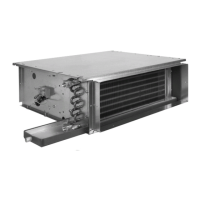UNT-SVX07B-EN 95
Start-Up
Electric Heat Operation
The Tracer ZN520 controller supports one or two-stage electric heat operation for heating. To
control the space temperature, electric heat is cycled to control the discharge air temperature. The
rate of cycling is dependent upon the load in the space and the temperature of the incoming fresh
air from the economizer (if any). Two-pipe changeover units with electric heat use the electric heat
only when hot water is not available.
Manual Fresh Air Damper
Units with the manual fresh air damper option ship with the damper in the closed position, which
is adjustable from zero to 100% in 25% increments. To adjust the position, first remove the air filter
to expose the damper stop screw on the control panel end. Relocate the stop screw to the
appropriate position. Then loosen the stop screw wingnut and adjust the linkage.
Economizer Damper Option
With a valid outdoor air temperature (either hardwired or communicated), Tracer ZN520 uses the
modulating economizer damper as the highest priority source of cooling. Economizer operation is
only possible through the use of a modulating damper.
Economizing is possible during the occupied, occupied standby, unoccupied, and occupied bypass
modes.
The controller initiates the economizer function if the outdoor air temperature is cold enough to be
used as free cooling capacity. If the outdoor air temperature is less than the economizer enable
setpoint (absolute dry bulb), the controller modulates the outdoor air damper (between the active
minimum damper position and 100%) to control the amount of outdoor air cooling capacity. When
the outdoor air temperature rises 5°F above the economizer enable point, the controller disables
economizing and moves the outdoor air damper back to its predetermined minimum position
based on the current occupancy mode or communicated minimum damper position.
Dehumidification
Dehumidification is possible when mechanical cooling is available, the heating capacity is located
in the reheat position, and the space relative humidity setpoint is valid.The controller starts
dehumidifying the space when the space humidity exceeds the humidity setpoint.
The controller continues to dehumidify until the sensed humidity falls below the setpoint minus
the relative humidity offset.The controller uses the cooling and reheat capacities simultaneously
to dehumidify the space. While dehumidifying, the discharge air temperature is controlled to
maintain the space temperature at the current setpoint.
A typical scenario involves high humidity and high temperature load of the space.The controller
sets the cooling capacity to 100% and uses the reheat capacity to warm the discharge air to maintain
space temperature control. Dehumidification may be disabled via Tracer or configuration.
Note: If the unit is in the unoccupied mode, the dehumidification routine will not operate.
Table 25. Relationship between outdoor temperature sensors and damper position
Outdoor Air Temp. Modulating Outdoor Air Damper
Occupied or
Occupied Bypass Occupied Standby Unoccupied
None or invalid Open to occupied
minimum position
Open to occupied standby minimum
position
Closed
Failed Open to occupied
minimum position
Open to occuied standby minimum
position
Closed
Present and economizing
feasible
Economizing minimum
postion to 100%
Economizing between occupied
standby minimum position to 100%
Open & economizing when
unit is operating, closed
Present & economizing
not feasible
Open to occupied
minimum position
Open to occupied standby minimum
position
Closed

